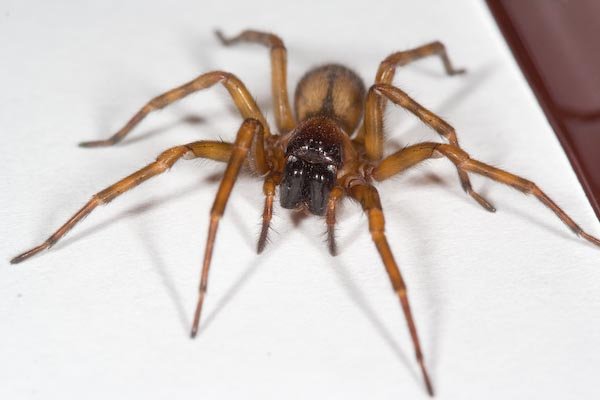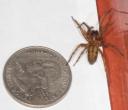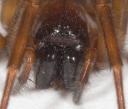Species #9: Hacklemesh Weaver
Hacklemesh Weaver
Callobius pictus
Thanks to Eric Eaton via bugguide.net for the family identification. The name ‘Hacklemesh Weaver’ is for the family group, not the individual species (which does not seem to have a common name).
Thanks to Jozef Slowik via Nearctic Arachnologists’ Forum for the species identification. He has written a paper on a survey of spiders on Chichagof Island (pdf) that I suspect will be helpful for figuring out the species of spiders I might find in the future.
I noticed this spider crawling down the side of a trash box while working on my computer this evening. It was a little distracting to see something large and dark slowly moving out of the corner of my eye. However, with this project as motivation, I took advantage of the situation and put it in a jar. It was pretty active, so I tried the refrigerator trick and after a few minutes it was far less active. I placed in a glass baking pan with paper on the bottom to take the pictures. At first its legs were all pulled in tight, but eventually it spread them out a little bit. After a few minutes it warmed up again and started moving around. Let’s just say it can be a little startling to be looking through the camera trying to take a close up of a spider’s face and then have it come scurrying rapidly toward you(r lens).
I have no idea how to identify spiders at this point, so I’ve submitted the photo to bugguide.net and the Nearctic Arachnologists’ Forum and will hope for some help.






hay i was wodnering if this spider is posions or not?
Comment by linda clay — June 1, 2011 @ 2:19 pm
As far as I know, they are not.
Comment by goff — June 2, 2011 @ 9:19 pm
Every spider in the world is venomous, There is no such thing as a non-venomous spider.
Comment by Ch0chita — June 11, 2011 @ 2:52 pm
Are these typically found in Central California? I have one that is strikingly similar. Where the legs meet at the thorax is almost in the shape of a heart.
Comment by ravyn — April 1, 2013 @ 11:06 am
I’m not sure what the range of this species is.
Comment by goff — April 15, 2013 @ 4:34 pm